Locronan
Locronan (French pronunciation: [lɔkʁɔnɑ̃]; Breton: Lokorn) is a commune in the Finistère department of Brittany in north-western France, with a population of 800.
Locronan
Lokorn | |
|---|---|
 The church square | |
.svg.png.webp) Coat of arms | |
Location of Locronan | |
 Locronan 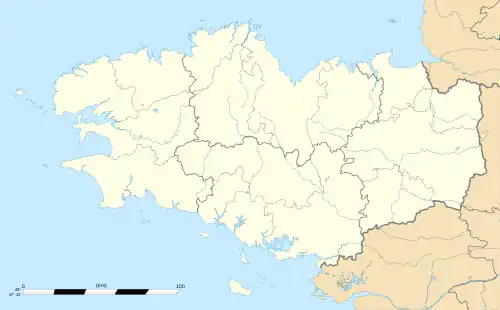 Locronan | |
| Coordinates: 48°06′00″N 4°12′24″W | |
| Country | France |
| Region | Brittany |
| Department | Finistère |
| Arrondissement | Quimper |
| Canton | Quimper-1 |
| Intercommunality | Quimper Bretagne Occidentale |
| Government | |
| • Mayor (2020–2026) | Antoine Gabrièle[1] |
| Area 1 | 8.08 km2 (3.12 sq mi) |
| Population | 790 |
| • Density | 98/km2 (250/sq mi) |
| Time zone | UTC+01:00 (CET) |
| • Summer (DST) | UTC+02:00 (CEST) |
| INSEE/Postal code | 29134 /29180 |
| Elevation | 38–280 m (125–919 ft) (avg. 145 m or 476 ft) |
| 1 French Land Register data, which excludes lakes, ponds, glaciers > 1 km2 (0.386 sq mi or 247 acres) and river estuaries. | |
Locronan is a member of the Les Plus Beaux Villages de France ("The most beautiful villages of France") association.[3]
Toponymy
The village's name means the "hermitage of Ronan", from the Breton lok ("hermitage") of Saint Ronan. It was previously known as Saint-René-du-Bois.
Saint Ronan, greatly venerated in Brittany, was a 6th-century Irish Christian missionary who came to the region to teach the people. As his association with Locronan is close, some of his relics are kept in the parish church.
History
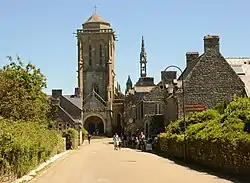
Locronan is a small town built at the foot of a hill. It was granted town status in 1505 by Anne of Brittany, who went there on a pilgrimage.
Since the 15th century, hemp has naturally grown in the area (see Hemp in France). It was cultivated and processed in a hemp industry in the town at the time, and it was widely used. The town was quite prosperous. Its hemp was exported internationally, as it was used for rigging the ships, both commercial and military, that operated from Brittany's many ports. The Saint Ronan church was built in this period, as well as the small chapel of Penity.
Population
Inhabitants of Locronan are called in French Locronanais.
|
|
|
Breton language
The municipality launched a plan through Ya d'ar brezhoneg on 23 November 2007 to revive the Breton language.
Events
Troménie is a pilgrimage festival that includes a large procession, whose participants carry the banners of participating parishes.
Held every six years between the second and third Sundays in July, the Grande Troménie is a pilgrimage of about 12 km, traversing the wider sacred area around Locronan. In the intervening five years, the Petite Troménie is held on the second Sunday in July. It is based in the town and church of Locronan. These are among the major pardons or ceremonies of the traditional Breton festal calendar.
Popular culture
Locronan has been used as a setting in films:
- Tess (1979), directed by Roman Polanski
- A Very Long Engagement, directed by Jean-Pierre Jeunet
- Chouans!, directed by Philippe de Broca
Gallery
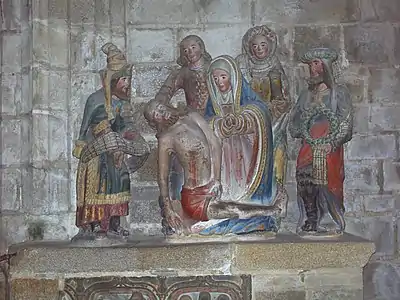 A notable image of the Deposition of Christ in the church at Locronan.
A notable image of the Deposition of Christ in the church at Locronan. The banner of St Ronan.
The banner of St Ronan.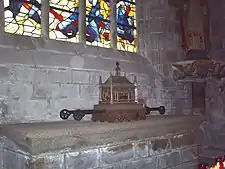 Reliquary holding relics of St Ronan at Locronan.
Reliquary holding relics of St Ronan at Locronan. Tomb of St Ronan.
Tomb of St Ronan. Scenes from the life of St Ronan on the polychrome pulpit at Locronan parish church.
Scenes from the life of St Ronan on the polychrome pulpit at Locronan parish church.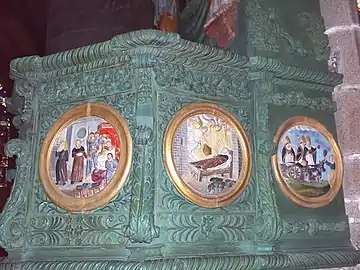 More scenes from the life of St Ronan on the pulpit.
More scenes from the life of St Ronan on the pulpit.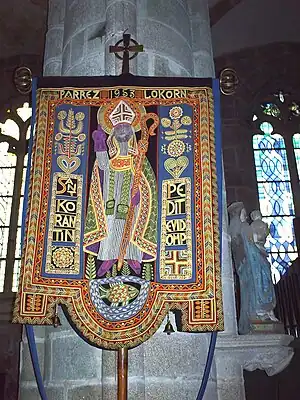 The banner of St Corentin of Quimper at Locronan.
The banner of St Corentin of Quimper at Locronan. Altar of the Rosary.
Altar of the Rosary.
See also
References
- "Répertoire national des élus: les maires". data.gouv.fr, Plateforme ouverte des données publiques françaises (in French). 2 December 2020.
- "Populations légales 2020". The National Institute of Statistics and Economic Studies. 29 December 2022.
- "Locronan (Département du Finistère): Cité de granit en pays de Quimper". Les Plus Beaux Villages de France. Retrieved 25 February 2023.
External links
- (in French) Official site
- (in French) Official site of the Office de Tourisme
- Gallery of Images on Treakearth
- Base Mérimée: Search for heritage in the commune, Ministère français de la Culture. (in French)